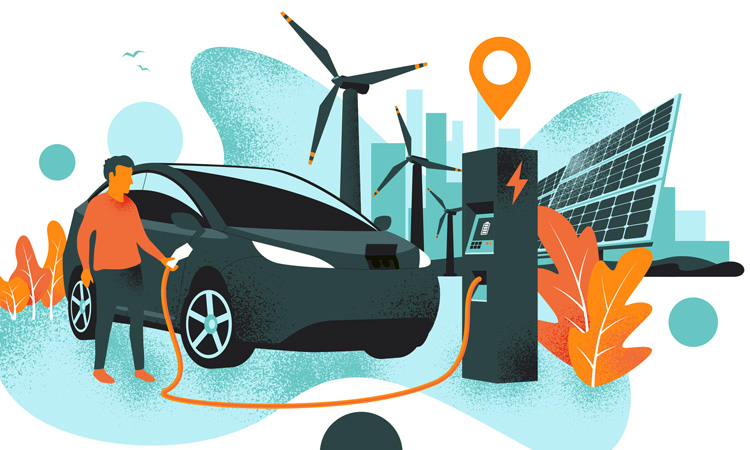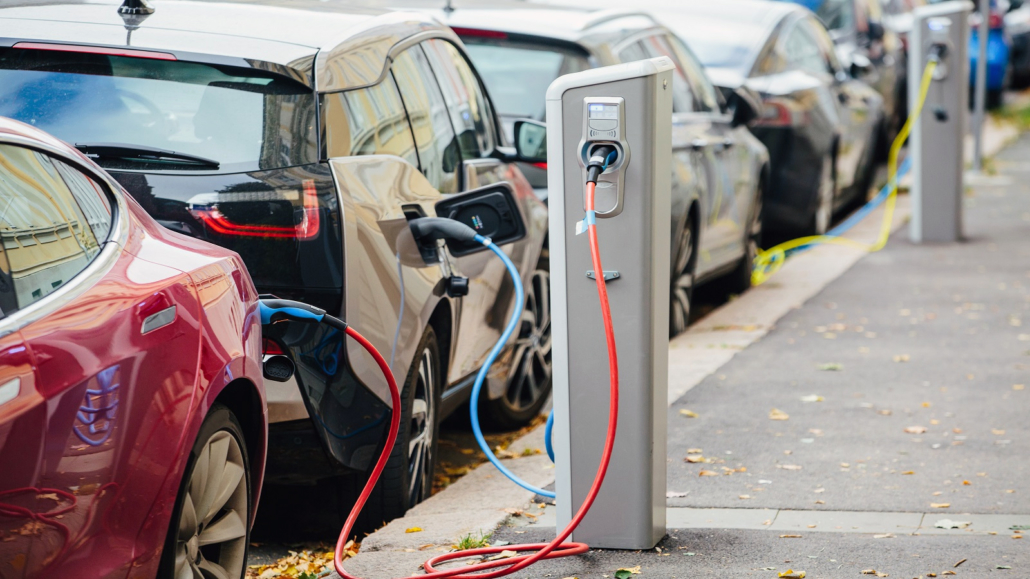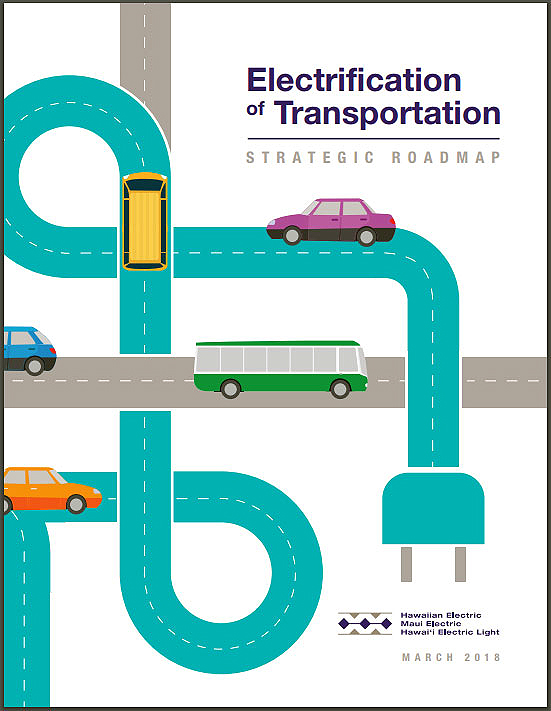Earth Day, 50 – Part 2: Hawaii at the Crossroads of Energy and Transportation
The State of Hawaii established itself early on a leader in the advancement and transition to renewable energy. This early leadership took the form of today’s Renewable Energy Portfolio (RPS) and a statewide goal that by the year 2045 the state’s electricity grid would be 100% powered by renewable energy.
The idea behind the sea-change in Hawaii’s energy policy was two-fold.
First, achieve “energy independence” from imported oil and other fossil fuels powering the state’s electricity grid.
Second, address what was even back in the 1990’s an emerging concern, the of effects of “global warming” on Hawaii and the planet – since re-named by republican strategists to the less alarming title of “climate change”.
Here Comes the Sun
Hawaii is truly all-in with renewable energy and it was easy to understand why – the state’s abundant sun and wind coupled to obvious benefits of a ready made, zero emissions, and local energy supply. It was less so with the emerging field of so-called bio-energy, case in point, Hawaii Island’s controversial tree-burning power plant Hu Honua (pending approval).
With solar and wind energy, there are no supply chain problems or petro resource wars to get in the way of the consumer, affordability, and sustainability when you’re energy is self-sufficient and locally produced, stored and ready when needed.
Globally abundant natural energy sources, like the sun and wind, have the added advantage of scale, and when coupled to low cost energy storage options (as compared to building and maintaining power-peaker plants), and they can easily become a 24×7 reliable energy source coupled to batteries (example, Kauai) to meet on-demand power requirements and the variability of weather and today’s electrical grid demands – and this begun in earnest, island-by-island with the objective of completing the state’s clean energy transformation.
The Promise of an All-Electric Future Must Include Transportation
In the recent past and present, significant advances are being made in the quest replace fossil-fueled aircraft and marine cargo vessels. The advancements have ranged from military to commercial bio-fueled and all-electric aircraft.
Boeing and AirBus are developing both all-electric and electric hybrid commercial scale passenger aircraft, all of which hold a promising future for clean fuel and zero emissions flight. In Asia, low emissions marine cargo vessels are also in development.
Hawaii’s near term prospects look good for the state’s transition off its imported energy needed to fuel cars and trucks, a transportation segment of the economy which accounts for a substantial portion amount of state’s local air pollution and greenhouse emissions.
The 21st Century (re) Birth of Personal and Electrified Transportation Options
What really kicked off the race to electrification of world’s economy was greater efficiency, advancements that date back to the space race of 1960’s.
Marked by the wide scale arrival of computerization, replacing mechanical gears and wheels with integrated circuits, this transformation help to create a communications revolution and what we take for granted today in the form of a global Internet. Integrated circuits also made possible an array of electronic products and services, utility scale wind and PV solar energy, and a virtual and electronic driven economy that now produces electric vehicles (EV) at mass market scale — and technology advances that have laid the foundation for society’s transition to a totally-electrified economy powered by clean energy and powering electric power vehicles directly from the sun.
In a strange mix of politics, legacy business interests, massive technology innovation, an environmental and social mandates to move beyond our polluted past, electric vehicles morphed from golf carts to EV replacements for 100 year old ICE (Internal Combustion Engine) vehicles.
Several ICE (internal combustion engine) auto manufactures have put their toe in the water with select entries into the all-electric vehicle market. Examples include, GM’s Volt, since replaced by the all-battery Bold EV, and Nissan’s Leaf. The Volt and the Leaf date back to their introductions in 2012, and in EV tech years, that is a technological lifetime.
In the early 2000’s, half attempts at electrification also came from other manufacturers which arrived in the form of hybrid cars (mostly gas powered cars, with a little added battery boost). These first battery-assist hybrid vehicles were EV-light – very, very light and built on an ICE drivetrains with small battery packs added almost as an afterthought, and to mostly meet California’s strict vehicle pollution rules. First introduced by Toyota and Honda in 1999, hybrid vehicles remain with us to this day, but fail in efficiency, lifetime ownership cost, and performance compared to their pure battery-electric cousins.
Modern breakthroughs in the commercialization of EV vehicles came from the first new and successful American car company in the last 100 years… Tesla, now the considered the benchmark for all-electric passenger and cargo ground transportation trucks.
The simple fact is for the majority of manufacturers attempting to enter the EV market they have been slow to do so. Beyond business transformation issues, EV’s are extremely difficult to build at mass production scale for traditional car companies. Technology challenges in battery technology and software, combined with Tesla’s decade old technology head start has left legacy ICE manufactures in their own dust; primary reasons for the current gap in EV vehicle selections in any showroom near you.
Electric Vehicle consumer demand is primarily driven by two things; product availability and value.
For Hawaii, California, and other states working to electrify their roadways, limited EV selection, in both models and price ranges has been a diminishing barrier of entry for potential new buyers. Tesla’s broadening selection of EV models represents the company’s move to deliver desirable models that are within the price range of many of Hawaii’s residents. Tesla’s introduction of its popular Model 3 sedan, is now in a price configuration competitive with Toyota, Hyundai, Kia, BMW, GM and other popular brands in Hawaii. Ford, Rivian, and Tesla will also be delivering all-electric pick-up trucks and SUV’s, over the next two to three years. Tesla began delivering its new low cost SUV, the Model Y, earlier this year.
So, if you are in the market for a new car or SUV, you should consider an EV of choice test drive. Beyond greater selection and lower EV prices in the Hawaii market, you have to wait and special order your new EV car or SUV, as dealer support for this EV product transition has been hit and miss for a variety of reasons, which we will explore in future articles.
A traditional purchase consideration for new EV car buyers has been driving range. Better known as “range anxiety”. Limited EV driving ranges are pretty much a thing of the past, with most models coupled to advances in battery and software technology now offering driving ranges between charges of 200 to 300, and even 400 miles range between charges.
Another area of concern is purchase cost, not unique to EV buyers. Unlike many other states, Hawaii does not provide new EV owners with a tax credit on their new purchase. There are several bills in the works designed to address this deficiency that have been deferred to the state’s next legislature session.
PV to EV, Hawaii’s path to energy independence and sustainability
Hawaii faces the challenge of maintaining public, businesses, and legislature support in order for the state to succeed in achieving needed and transformative measures. There is growing public support for EV’s, which is understandable when you talk to Hawaii’s EV owners who praise their EV’s for handily demonstrating their ownership values: reliability, performance, and significant improvements from their previously owned ICE vehicles, in both lower operating and fuel costs. Lower fuel costs may vary depending where and what you plug your EVv into for a charge (to fuel it). Near zero maintenance is often cited as an EV ownership benefit. No costly visits to the dealer for service and the elimination of gas station stops are EV ownership benefits which are hard to deny.
The greatest environmental benefits to society from statewide EV ownership come in combination with rooftop solar. This is truly a zero sum emissions benefit to both society and EV owners, and when electric transportation truly comes into its own; directly fueling from your car or truck from the Sun; PV to EV.
Not everyone is fortunate enough to have a garage and home equipped with both solar and an EV charging station. And finding a working and convenient public charging station today in Hawaii is more a matter of luck than planning.
The statewide development of an EV charging infrastructure is essential to the growth and acceleration of what has been a slow climb to mass market acceptance and adoption of EV’s, certainly, beyond the niche role they presently play in Hawaii’s transportation mix. Early adopters can carry this needed transformation only so far. State and/or private sector stakeholders must participate in the development and operation of an a cost-effective and convenient EV charging infrastructure, island-by-island designed to serve all of Hawaii.
Necessity has been called the mother of invention. Hawaii’s state government may not or will not fund the needed charging infrastructure build out to fully transform the state’s transportation off its current  fossil fuel dependencies. So it becomes essential that a market transition of this magnitude go beyond the current and proverbial cart and horse discussion of policy, into an execution stage.
fossil fuel dependencies. So it becomes essential that a market transition of this magnitude go beyond the current and proverbial cart and horse discussion of policy, into an execution stage.
HECO, the state’s largest electricity retailer has been readying itself for some time now, with a PUC push, to be one of several possible candidates that will build and manage a statewide charging infrastructure, and within the utility’s island-specific service territories.
There are also companies which specialize in building and servicing public EV charging systems on a grand scale, some examples include:
ChargePoint – previously called Coulomb Technologies – claims to manage the world’s largest network of electric vehicle charging points.
ABB — leading supplier of “downstream” solar and other power equipment components recently unveiled a range of charging solutions for fast charging of buses and cars.
EVgo — operates one of the largest network of public electric fast-charging stations in the US.
From Hawaii to California to Europe there are companies ready to step in and fulfill Hawaii’s EV charging infrastructure requirements.
Electric Vehicles – the tip of the spear
It’s estimated that there are more than 1 billion cars on the world’s roads. Of these, around 2 to 3 million are pure battery-electric and plug-in hybrid electric vehicles, according to the International Energy Agency (IEA), which further forecasts that there will be 300-400 million EVs on the road, of the approximately 2 billion vehicles projected by 2040. Proportionately, that is about 2% of the vehicles will all-electric and plug-in models.
The IEA is notorious for under-counting the EV market potential, understandable considering the organization’s fossil fuel funding roots. By IEA’s calculation, in 20 years Hawaii’s fleet of electric vehicles will eventually reach only 2% of registered cars and trucks. Last year, the state’s 2019 EV registrations had reached 1% of all registered vehicles, and that number is projected to more than double in the next 3-5 years, and not take another 20 years as IEA has projected.
COVID-19 has presented many new near term challenges and economic priorities for the state which the private sector and the general public must now address these new and unexpected challenges. The long held policy objectives that will ensure Hawaii’s sustainability and lessening its imported energy dependency connected to a fragile supply chain must proceed, but at a faster pace.
If the current pandemic has demonstrated anything, it is that our business-as-usual assumptions are false. The state’s long held sustainability and self-sufficiency goals, plans, and objectives, once considered farsighted, are now essential to Hawaii’s future.



Leave a Reply
Join the Community discussion now - your email address will not be published, remains secure and confidential. Mahalo.